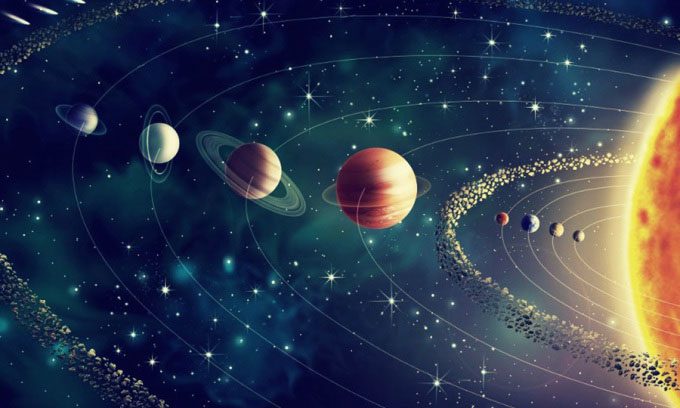Although they may appear close to each other and relatively aligned when viewed from Earth, the planets are actually very far apart in the universe.
During their journey around the Sun, some planets may seem to line up from the perspective of Earth. But do these eight planets really align? The answer depends on the definition of “alignment.”

The Solar System consists of eight planets: Mercury, Venus, Earth, Mars, Jupiter, Saturn, Uranus, and Neptune. (Image: Orbital Today)
The eight planets in the Solar System are Mercury, Venus, Earth, Mars, Jupiter, Saturn, Uranus, and Neptune. The orbits of these planets tilt at various angles relative to the solar equator. This means that even when they appear aligned in the sky, they may not actually be in a straight line in 3D space, according to Arthur Kosowsky, an astrophysicist at the University of Pittsburgh.
“The concept of planet alignment is more about what can be observed from the human perspective on Earth rather than actual physical alignment in space“, Nikhita Madhanpall, an astrophysicist at the University of Wits, South Africa, stated.
Planetary conjunctions occur when two or more planets appear close to each other when viewed from Earth. It is important to note that these planets are not actually near each other. Even when they seem aligned from our perspective, they remain extremely distant from one another in the universe.
How close do planets need to be to be considered aligned? This has not been clearly defined, according to Wayne Barkhouse, an astrophysicist at the University of North Dakota. This definition will relate to the angular distance – how astronomers measure the apparent distance between two celestial bodies in the sky.
If you measure the distance around the entire circle of the horizon, the result will be 360 degrees. To visualize the vastness of the horizon, keep in mind that a full moon only has a diameter of half a degree, according to the Las Cumbres Observatory in Goleta, California.

Saturn (top) and Jupiter (bottom) appeared close to each other when viewed from Shenandoah National Park, USA, on December 13, 2020. (Image: Bill Ingalls/NASA).
In his 1997 book “Mathematical Astronomy Morsels,” Jean Meeus, a Belgian meteorologist and amateur astronomer, calculated that three planets in the inner Solar System – Mercury, Venus, and Earth – align within 3.6 degrees on average every 39.6 years.
Alignments involving more than three planets take much longer. According to Meeus, all eight planets will align within 3.6 degrees every 396 billion years. “Thus, this event has never occurred and will not occur, as the Sun will become a white dwarf in about 6 billion years. During this process, the Sun will evolve into a red giant and expand, potentially engulfing both Mercury and Venus, possibly even Earth. Therefore, only five planets will remain in the Solar System,” Barkhouse remarked.
The chance of all eight planets aligning within one degree in the sky is even lower. According to Meeus, this occurs on average every 13.4 trillion years. Meanwhile, the universe is believed to be only about 13.8 billion years old.
If we consider the eight planets to be aligned when they occupy the same section of the sky measuring 180 degrees, the next time this event will occur is on May 6, 2492, according to Christopher Baird, an associate professor of physics at West Texas A&M University. The last time all eight planets aligned within 30 degrees was on January 1, 1665, and the next occurrence will be on March 20, 2673, according to data from the National Solar Observatory at Sacramento Peak, California.
Madhanpall noted that the alignment of planets has virtually no significant physical impact on Earth. “The only effect on life on Earth during planetary alignments is a spectacular display in the sky. There is no risk of increased earthquakes or anything similar. The gravitational changes that Earth experiences during any planetary alignment event are negligible,” Barkhouse explained.


















































